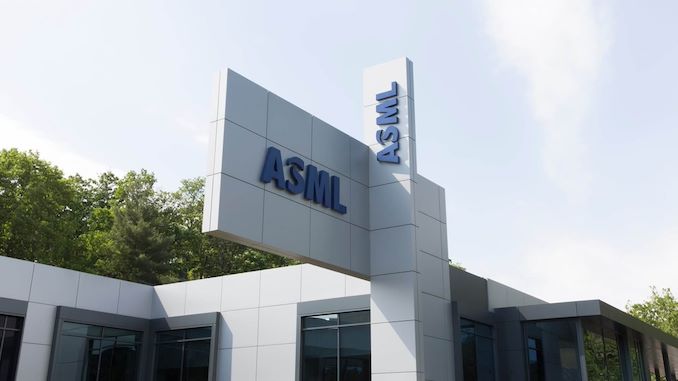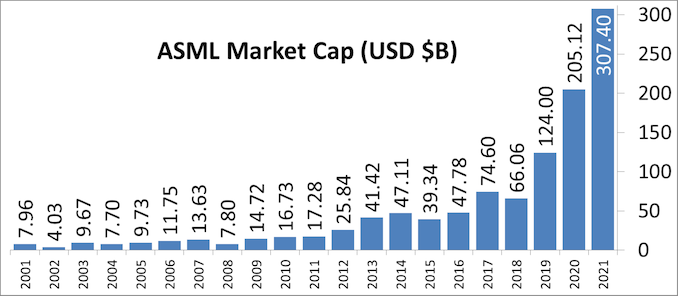Intel's Process Roadmap to 2025: with 4nm, 3nm, 20A and 18A?!
by Dr. Ian Cutress on July 26, 2021 5:00 PM ESTSidebar on Intel EUV
In all of these announcements, one thing to highlight is Intel mentioning its relationship with ASML, the sole company that manufactures the EUV machines powering production of leading edge semiconductor manufacturing.
ASML is a unique company in that it is the only one that can produce these machines, because the technology behind them is often tied up with its partners and research, but also because all the major silicon manufacturers are heavily invested in ASML. For any other company to compete against ASML would require building a separate network of expertise, a decade of innovation and design, and a lot of capital. None of the major silicon vendors want to disturb this balance and go off on their own, lest it shuts them out of the latest manufacturing technology, and no research fund sees competing against the embedded norm as a viable opportunity. This means that anyone wanting EUV specialist technology has to go to ASML.
In 2012, it was reported that Intel, Samsung, and TSMC all invested in ASML. This was, at the time, to jumpstart EUV development along with migrating from 300mm wafers to 450mm wafers. While we haven’t moved to 450mm wafers yet (and there are doubts we will any time in the next decade), EUV is now here. Intel’s 2012 investment of $2.1 billion gave them a 10% stake in ASML, with Intel stating that it would continue investing up to a 25% stack. Those stakes are now below the 5% reporting threshold, but all three of the major foundry customers are still big owners, especially as ASML’s market cap has risen from $24 Billion in 2012 to $268 Billion in 2021 (surpassing Intel).
As major investors but also ASML’s customers, the race has been on for these foundries to acquire enough EUV machines to meet demand. TSMC reported in August 2020 that it has 50% of all EUV machines manufactured at ASML for its leading edge processes. Intel is a little behind, especially as none of Intel’s products in the market yet use any EUV. EUV will only intercept Intel’s portfolio with its new Intel 4 process, where it will be used extensively, mostly on the BEOL. But Intel still has to order machines when they need them, especially as there are reports that ASML currently has backorders of 50 EUV machines. In 2021, ASML is expected to manufacture around 45-50 machines, and 50-60 in 2022. The exact number of machines Intel has right now, or has ordered from ASML, is unknown. It is expected that each one has a ~$150m price tag, and can take 4-6 months to install.
With all that being said, Intel’s discussion point today is that it will be the lead customer for ASML’s next generation EUV technology known as High-NA EUV. NA in this context relates to the ‘numerical aperture’ of the EUV machine, or to put simply, how wide you can make the EUV beam inside the machine before it hits the wafer. The wider the beam before you hit the wafer, the more intense it can be when it hits the wafer, which increases how accurately the lines are printed. Normally in lithography to get better printed lines, we move from single patterning to double patterning (or quad patterning) to get that effect, which decreases yield. The move to High-NA would mean that the ecosystem can stay on single patterning for longer, which some have quoted as allowing the industry to ‘stay aligned with Moore’s Law longer’.
| ASML's EUV Shipments | |||||||||||||||||||||
| 2015 | 2016 | 2017 | 2018 | 2019 | 2020 | 2021 | |||||||||||||||
| Actual | 2 | 4 | 10 | 3 | 4 | 5 | 6 | 4 | 7 | 7 | 8 | 4 | 7 | 14 | 8 | 7 | 9 | - | - | ||
| Target (Total) | - | - | - | 20 (18) | 30 (26) | 35 (33) | 45-50 | ||||||||||||||
| 2018 and beyond is split per quarter for actual shipped numbers Data taken from ASML's Financial Reports |
|||||||||||||||||||||
Current EUV systems are NA 0.33, while the new systems are NA 0.55. ASML’s latest update suggests that it expects customers to be using High-NA for production in 2025/2026, which means that Intel is likely going to be getting the first machine (ASML NXE:5000 we think) in mid-2024. Exactly how many High-NA machines ASML intends to produce in that time frame is unknown, as if they flood the market, having the first won’t be a big win. However if there is a slow High-NA ramp, it will be up to Intel to capitalize on its advantage.













326 Comments
View All Comments
mode_13h - Thursday, July 29, 2021 - link
Good journalism requires impartiality, which is hard to maintain when you're directly involving yourself in the agenda of those you're reporting on.Impartiality isn't about not having opinions. It's about separating them from one's reporting.
Oxford Guy - Thursday, July 29, 2021 - link
Impartiality is a myth.Everyone brings many biases, regardless of what label they stick on themselves. It's better to be open about those biases than to feign objectivity.
Come clean with one's biases (as much as one can, since they are a form of blindness) and, simultaneously, try to present the facts — clearly/thoroughly.
Your vision of a journalist sounds like a stenographer. Journalism is supposed to have activism as part of its function. That's what makes it different from stenography.
mode_13h - Sunday, August 1, 2021 - link
> Impartiality is a myth.How lame. Just because there's no such thing as a perfectly neutral reporter doesn't mean that journalistic standards don't still have value.
> It's better to be open about those biases than to feign objectivity.
This is a canard used to legitimize partisan media. Time and again, surveys of consumers of partisan media have been shown to be less well-informed about relevant subject material.
> Come clean with one's biases
Yes, conflict of interests should be disclosed. However, one should take reasonable measures not to *further* said entanglements. That makes objectivity even more difficult.
> Your vision of a journalist sounds like a stenographer.
No, and I already explained the difference.
> Journalism is supposed to have activism as part of its function.
No, but thanks for at least confirming your ignorance on the subject.
https://en.wikipedia.org/wiki/Journalism_ethics_an...
Activism should be reserved for editorials. There should be a bright line between reporting and editorial content.
> That's what makes it different from stenography.
No. Where it differs is by providing context and fact-checking.
Spunjji - Friday, July 30, 2021 - link
@mode_13h - I guess I just disagree with you that Ian has "involved [him]self in the agenda" of Intel by advocating for some sort of change in their process naming conventions. It's equally likely he was tired of having to write articles explaining the difference between foundry Xnm and Intel XXnm, and/or the difference between "++", "+++" and "ESF".GeoffreyA - Friday, July 30, 2021 - link
I've got to agree with Ian's trying to shake some sense into Intel.GeoffreyA - Saturday, July 31, 2021 - link
I think both points of view are right (mode_13h's and Oxford Guy's) and need to be combined.mode_13h - Sunday, August 1, 2021 - link
> both points of view are right ... and need to be combined.Um, how?
GeoffreyA - Sunday, August 1, 2021 - link
While perfect impartiality is hard to find, it does exist as an ideal which we've got to keep before us. Without that gold standard, practice would sink lower and lower.mode_13h - Sunday, August 1, 2021 - link
> I just disagree with you that Ian has "involved [him]self in the agenda"> of Intel by advocating for some sort of change in their process naming conventions.
What it does is give him a sense of ownership of their new process naming scheme, and that risks coloring his reporting. I'm not going to reread the entire article just to find examples, but I did note a few instances of what seemed to be favorable coverage. I can't say that's the result of his advocacy, but I wouldn't even have the question if he hadn't committed it.
> It's equally likely he was tired of having to write articles explaining the difference
> between foundry Xnm and Intel XXnm, and/or the difference between "++", "+++"
> and "ESF".
First, that's not a good excuse for advocacy. Reporters always face the issue of having to provide context for readers who haven't been following the subject closely. The magic of hyperlinks can be used to minimize the amount of repetition, by simply writing an explainer and linking to it from articles that deal with the relative differences between process nodes.
Second, he's still going to be in a similar position of potentially having to explain the differences between a given TSMC node and whichever Intel node is relevant. So, I don't see how this really improves the situation.
Oxford Guy - Wednesday, August 11, 2021 - link
Slapping the word ‘editorial’ onto a piece of writing doesn’t magically change it.All it does is typically label the piece an example of casual sloppy thinking.